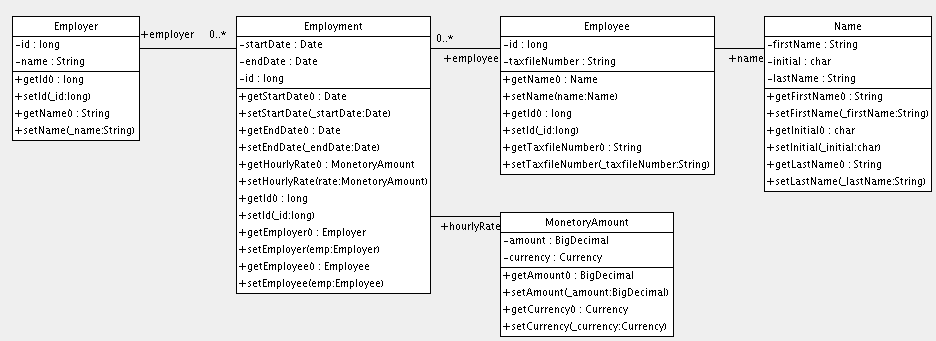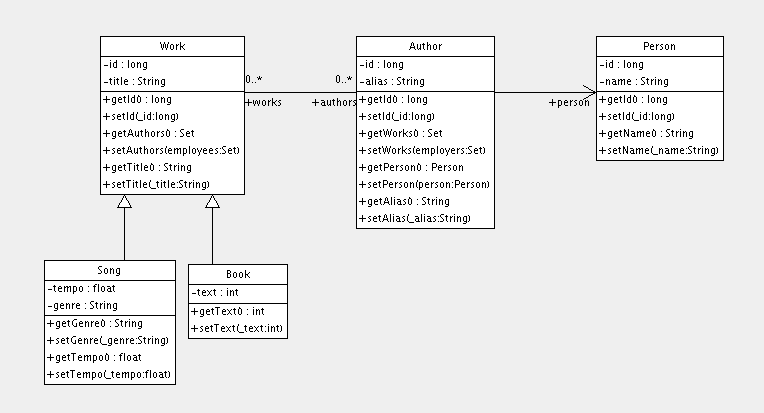Table of Contents
This chapters explores some more complex association mappings.
The following model of the relationship between Employer and
Employee uses an entity class (Employment)
to represent the association. You can do this when there might be more than one
period of employment for the same two parties. Components are used to model monetary
values and employee names.

Here is a possible mapping document:
<hibernate-mapping>
<class name="Employer" table="employers">
<id name="id">
<generator class="sequence">
<param name="sequence">employer_id_seq</param>
</generator>
</id>
<property name="name"/>
</class>
<class name="Employment" table="employment_periods">
<id name="id">
<generator class="sequence">
<param name="sequence">employment_id_seq</param>
</generator>
</id>
<property name="startDate" column="start_date"/>
<property name="endDate" column="end_date"/>
<component name="hourlyRate" class="MonetaryAmount">
<property name="amount">
<column name="hourly_rate" sql-type="NUMERIC(12, 2)"/>
</property>
<property name="currency" length="12"/>
</component>
<many-to-one name="employer" column="employer_id" not-null="true"/>
<many-to-one name="employee" column="employee_id" not-null="true"/>
</class>
<class name="Employee" table="employees">
<id name="id">
<generator class="sequence">
<param name="sequence">employee_id_seq</param>
</generator>
</id>
<property name="taxfileNumber"/>
<component name="name" class="Name">
<property name="firstName"/>
<property name="initial"/>
<property name="lastName"/>
</component>
</class>
</hibernate-mapping>
Here is the table schema generated by SchemaExport.
create table employers (
id BIGINT not null,
name VARCHAR(255),
primary key (id)
)
create table employment_periods (
id BIGINT not null,
hourly_rate NUMERIC(12, 2),
currency VARCHAR(12),
employee_id BIGINT not null,
employer_id BIGINT not null,
end_date TIMESTAMP,
start_date TIMESTAMP,
primary key (id)
)
create table employees (
id BIGINT not null,
firstName VARCHAR(255),
initial CHAR(1),
lastName VARCHAR(255),
taxfileNumber VARCHAR(255),
primary key (id)
)
alter table employment_periods
add constraint employment_periodsFK0 foreign key (employer_id) references employers
alter table employment_periods
add constraint employment_periodsFK1 foreign key (employee_id) references employees
create sequence employee_id_seq
create sequence employment_id_seq
create sequence employer_id_seq
Consider the following model of the relationships between Work,
Author and Person. In the example, the relationship
between Work and Author is represented as a many-to-many
association and the relationship between Author
and Person is represented as one-to-one association. Another possibility would be to
have Author extend Person.

The following mapping document correctly represents these relationships:
<hibernate-mapping>
<class name="Work" table="works" discriminator-value="W">
<id name="id" column="id">
<generator class="native"/>
</id>
<discriminator column="type" type="character"/>
<property name="title"/>
<set name="authors" table="author_work">
<key column name="work_id"/>
<many-to-many class="Author" column name="author_id"/>
</set>
<subclass name="Book" discriminator-value="B">
<property name="text"/>
</subclass>
<subclass name="Song" discriminator-value="S">
<property name="tempo"/>
<property name="genre"/>
</subclass>
</class>
<class name="Author" table="authors">
<id name="id" column="id">
<!-- The Author must have the same identifier as the Person -->
<generator class="assigned"/>
</id>
<property name="alias"/>
<one-to-one name="person" constrained="true"/>
<set name="works" table="author_work" inverse="true">
<key column="author_id"/>
<many-to-many class="Work" column="work_id"/>
</set>
</class>
<class name="Person" table="persons">
<id name="id" column="id">
<generator class="native"/>
</id>
<property name="name"/>
</class>
</hibernate-mapping>
There are four tables in this mapping: works,
authors and persons hold work, author
and person data respectively. author_work is an association
table linking authors to works. Here is the table schema, as generated by
SchemaExport:
create table works (
id BIGINT not null generated by default as identity,
tempo FLOAT,
genre VARCHAR(255),
text INTEGER,
title VARCHAR(255),
type CHAR(1) not null,
primary key (id)
)
create table author_work (
author_id BIGINT not null,
work_id BIGINT not null,
primary key (work_id, author_id)
)
create table authors (
id BIGINT not null generated by default as identity,
alias VARCHAR(255),
primary key (id)
)
create table persons (
id BIGINT not null generated by default as identity,
name VARCHAR(255),
primary key (id)
)
alter table authors
add constraint authorsFK0 foreign key (id) references persons
alter table author_work
add constraint author_workFK0 foreign key (author_id) references authors
alter table author_work
add constraint author_workFK1 foreign key (work_id) references works
In this section we consider a model of the relationships between Customer,
Order, Line Item and Product.
There is a one-to-many association between Customer and
Order, but how can you represent Order /
LineItem / Product? In the example,
LineItem is mapped as an association class representing the many-to-many
association between Order and Product. In
Hibernate this is called a composite element.

The mapping document will look like this:
<hibernate-mapping>
<class name="Customer" table="customers">
<id name="id">
<generator class="native"/>
</id>
<property name="name"/>
<set name="orders" inverse="true">
<key column="customer_id"/>
<one-to-many class="Order"/>
</set>
</class>
<class name="Order" table="orders">
<id name="id">
<generator class="native"/>
</id>
<property name="date"/>
<many-to-one name="customer" column="customer_id"/>
<list name="lineItems" table="line_items">
<key column="order_id"/>
<list-index column="line_number"/>
<composite-element class="LineItem">
<property name="quantity"/>
<many-to-one name="product" column="product_id"/>
</composite-element>
</list>
</class>
<class name="Product" table="products">
<id name="id">
<generator class="native"/>
</id>
<property name="serialNumber"/>
</class>
</hibernate-mapping>
customers, orders, line_items and
products hold customer, order, order line item and product data
respectively. line_items also acts as an association table linking
orders with products.
create table customers (
id BIGINT not null generated by default as identity,
name VARCHAR(255),
primary key (id)
)
create table orders (
id BIGINT not null generated by default as identity,
customer_id BIGINT,
date TIMESTAMP,
primary key (id)
)
create table line_items (
line_number INTEGER not null,
order_id BIGINT not null,
product_id BIGINT,
quantity INTEGER,
primary key (order_id, line_number)
)
create table products (
id BIGINT not null generated by default as identity,
serialNumber VARCHAR(255),
primary key (id)
)
alter table orders
add constraint ordersFK0 foreign key (customer_id) references customers
alter table line_items
add constraint line_itemsFK0 foreign key (product_id) references products
alter table line_items
add constraint line_itemsFK1 foreign key (order_id) references orders
These examples are available from the Hibernate test suite. You
will find many other useful example mappings there by searching in the
test folder of the Hibernate distribution.
<class name="Person">
<id name="name"/>
<one-to-one name="address"
cascade="all">
<formula>name</formula>
<formula>'HOME'</formula>
</one-to-one>
<one-to-one name="mailingAddress"
cascade="all">
<formula>name</formula>
<formula>'MAILING'</formula>
</one-to-one>
</class>
<class name="Address" batch-size="2"
check="addressType in ('MAILING', 'HOME', 'BUSINESS')">
<composite-id>
<key-many-to-one name="person"
column="personName"/>
<key-property name="type"
column="addressType"/>
</composite-id>
<property name="street" type="text"/>
<property name="state"/>
<property name="zip"/>
</class>
<class name="Customer">
<id name="customerId"
length="10">
<generator class="assigned"/>
</id>
<property name="name" not-null="true" length="100"/>
<property name="address" not-null="true" length="200"/>
<list name="orders"
inverse="true"
cascade="save-update">
<key column="customerId"/>
<index column="orderNumber"/>
<one-to-many class="Order"/>
</list>
</class>
<class name="Order" table="CustomerOrder" lazy="true">
<synchronize table="LineItem"/>
<synchronize table="Product"/>
<composite-id name="id"
class="Order$Id">
<key-property name="customerId" length="10"/>
<key-property name="orderNumber"/>
</composite-id>
<property name="orderDate"
type="calendar_date"
not-null="true"/>
<property name="total">
<formula>
( select sum(li.quantity*p.price)
from LineItem li, Product p
where li.productId = p.productId
and li.customerId = customerId
and li.orderNumber = orderNumber )
</formula>
</property>
<many-to-one name="customer"
column="customerId"
insert="false"
update="false"
not-null="true"/>
<bag name="lineItems"
fetch="join"
inverse="true"
cascade="save-update">
<key>
<column name="customerId"/>
<column name="orderNumber"/>
</key>
<one-to-many class="LineItem"/>
</bag>
</class>
<class name="LineItem">
<composite-id name="id"
class="LineItem$Id">
<key-property name="customerId" length="10"/>
<key-property name="orderNumber"/>
<key-property name="productId" length="10"/>
</composite-id>
<property name="quantity"/>
<many-to-one name="order"
insert="false"
update="false"
not-null="true">
<column name="customerId"/>
<column name="orderNumber"/>
</many-to-one>
<many-to-one name="product"
insert="false"
update="false"
not-null="true"
column="productId"/>
</class>
<class name="Product">
<synchronize table="LineItem"/>
<id name="productId"
length="10">
<generator class="assigned"/>
</id>
<property name="description"
not-null="true"
length="200"/>
<property name="price" length="3"/>
<property name="numberAvailable"/>
<property name="numberOrdered">
<formula>
( select sum(li.quantity)
from LineItem li
where li.productId = productId )
</formula>
</property>
</class>
<class name="User" table="`User`">
<composite-id>
<key-property name="name"/>
<key-property name="org"/>
</composite-id>
<set name="groups" table="UserGroup">
<key>
<column name="userName"/>
<column name="org"/>
</key>
<many-to-many class="Group">
<column name="groupName"/>
<formula>org</formula>
</many-to-many>
</set>
</class>
<class name="Group" table="`Group`">
<composite-id>
<key-property name="name"/>
<key-property name="org"/>
</composite-id>
<property name="description"/>
<set name="users" table="UserGroup" inverse="true">
<key>
<column name="groupName"/>
<column name="org"/>
</key>
<many-to-many class="User">
<column name="userName"/>
<formula>org</formula>
</many-to-many>
</set>
</class>
<class name="Person"
discriminator-value="P">
<id name="id"
column="person_id"
unsaved-value="0">
<generator class="native"/>
</id>
<discriminator
type="character">
<formula>
case
when title is not null then 'E'
when salesperson is not null then 'C'
else 'P'
end
</formula>
</discriminator>
<property name="name"
not-null="true"
length="80"/>
<property name="sex"
not-null="true"
update="false"/>
<component name="address">
<property name="address"/>
<property name="zip"/>
<property name="country"/>
</component>
<subclass name="Employee"
discriminator-value="E">
<property name="title"
length="20"/>
<property name="salary"/>
<many-to-one name="manager"/>
</subclass>
<subclass name="Customer"
discriminator-value="C">
<property name="comments"/>
<many-to-one name="salesperson"/>
</subclass>
</class>
<class name="Person">
<id name="id">
<generator class="hilo"/>
</id>
<property name="name" length="100"/>
<one-to-one name="address"
property-ref="person"
cascade="all"
fetch="join"/>
<set name="accounts"
inverse="true">
<key column="userId"
property-ref="userId"/>
<one-to-many class="Account"/>
</set>
<property name="userId" length="8"/>
</class>
<class name="Address">
<id name="id">
<generator class="hilo"/>
</id>
<property name="address" length="300"/>
<property name="zip" length="5"/>
<property name="country" length="25"/>
<many-to-one name="person" unique="true" not-null="true"/>
</class>
<class name="Account">
<id name="accountId" length="32">
<generator class="uuid"/>
</id>
<many-to-one name="user"
column="userId"
property-ref="userId"/>
<property name="type" not-null="true"/>
</class>